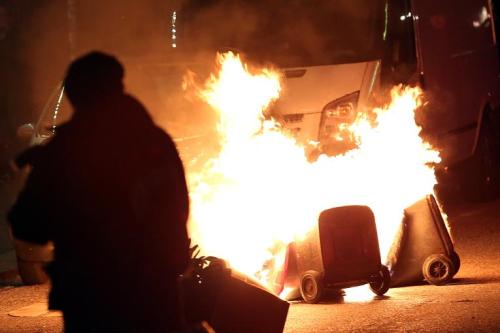Another Day, Another Riot
by cominsitu
Hamburg, Dec 21st, 2013. Rota Flora, Esso, Lampedusa.
Recent struggles reflect the two basic aspects of the process that produces the revolution of the current period: first, the delegitimization of demands, i.e. demanding is converted into a component of the reproduction of classes, which tends to be marginalized and suppressed, and second, the internal distance produced between proletarian practices in the evolution of class struggle. These two aspects of class struggle are produced in every zone of capital despite all their differences, and is imposed by the objectivity of capital, the economy. We may risk the prediction that we are entering into an era of riots, which will be transitional and extremely violent. It will define the reproduction crisis of the proletariat, and thus of capitalism, as an important structural element of the following period. By ‘riots’ we mean struggles for demands or struggles without demands that will take violent forms and will transform the urban environments into areas of unrest; the riots are not revolution, even the insurgency is not revolution, although it may be the beginning of a revolution. The internal distance between proletarian practices aggravates all social contradictions and creates a self-reinforcing process of growing conflicts that includes more and more categories of the working class and the intensification of State repression. The particularity of this ‘era’ is that the dynamics of the struggle cannot produce stable results. In any case, the struggles of the proletarians will inevitably reproduce the opponent class and their own class existence as a class of proletarians. The limit of these struggles, now, is the fact that they are class struggles. The only guarantee to overcome this limit is a practical attack against capital, which is identical with the attack on the very existence of the proletarian class.
– The Transitional Phase of the Crisis: the era of riots, Blaumachen 2011
One can today be a railway worker, yesterday unemployed, tomorrow a precarious worker, and the day after that a squatter or undocumented immigrant. Activism is the permanent ‘What is to be done?’ in an era where everything that constituted workers’ identity has vanished. It is a permanent ‘What is to be done?’ which no longer has the mediation between the particular struggles and the general existence of the class, that is to say, the workers’ identity and/or the (existing or to be built) Party, nor the maturation of the class. In all these definitions, there was, generally speaking, a ‘being’ of the proletariat to be revealed, whether this ‘being’ was explicit in its political, trade union, or institutional mediations or impeded by them. This generality of the proletariat implies that all particularities are nothing more than contingencies, accidents.
Caught without mediation in between the general and the particular, activism is a set of tactics that is always unsatisfied with both itself and anyone else (until the next action). As essentially tactics, activism functions like a tool box: generalisation of the action, overcoming of the categorial demands, self-organisation of the struggle, refusal of mediations, autonomy, etc. Consequently, if it is not definitive, it is a strong tendency: activism is normative. Action is then constructed as a question, i.e. as an intervention. The construction of this question makes an abstraction of the diversity of activities: Practice as an abstraction. The question of intervention transforms what is done (or what cannot be done) in this or that struggle—practices which are always particular—into an abstraction of practice. It justifies itself by fabricating a dilemma: intervention or waitism.
– The Movement Against the French Pension Reform, R.S., Sic 2 (forthcoming)
The era of riots is at the same time the dynamic and the limit of class struggle in the current conjuncture, namely the production of class belonging as an external constraint in the face of the inability of class struggle to conclude its class dynamic and produce a renewed position of proletarian power. It is only a transitory phase in the development of this contradiction (the contradiction between classes in the current cycle of struggles) that seeks a resolution. As the crisis progresses, the proletariat struggles for its reproduction as a class and at the same time is confronted with its own reproduction (class belonging) externalised as a constraint in capital, i.e. it struggles at the same time for and against its own reproduction. The generalisation of the struggle is not posed today as class unity (under the wings of a central figure), because for the proletariat being and acting as a class only means being a part of capital and reproducing itself as such (together with the opponent class). There is no ground for a revolutionary affirmation of class belonging, no workers’ identity or proletarian community, and there is nothing to be liberated, no craftsmanship or human nature. In an environment that produces surplus populations and violently attacks the historically defined value of labour power, anchoring on the wage relation is lost together with the ability to demand better living standards.
The much-anticipated Subject loses the ground beneath its feet. The ephemeral ‘us’ of the rioters, this transient subject of destructive practices that appears momentarily only to rapidly dissolve, is the impossibility of a permanence of the Subject (the impossibility to imagine the revolution as the result of an ‘accumulation’ or overgrowth of riots). In the differentiated character of the crisis of proletarian reproduction, the crisis of the stratification of the proletariat, each part is struggling to defend its respective level of reproduction (its position on the social ladder) while they are all pushed downwards. This makes the issue of the generalisation of the struggle an issue of conflictual encounter between different practices. This is revealed in all the cases of riots invading movements.
– The Feral Underclass Hits the Streets, Rocamadur/Blaumachen, Sic 2 (forthcoming)


